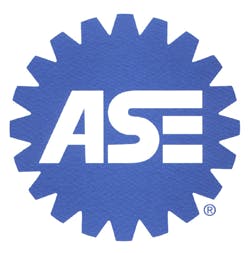Like this article? Sign up for our enews blasts here.
ASE has taken the lead in creating opportunity for all facets of technician education to interact with one another. To start at the beginning, Vo-Tech programs that have struggled to arm entry-level techs with viable work skills have a newly revised NATEF task list that places emphasis on developing skills necessary for a new tech to walk in and perform maintenance and light repair operations competently from their first day on the job. The fallout in those first critical years right out of trade school is very high. Young people are leaving school with huge debt and an inadequate ability to make money for an employer, and as a result, themselves. Many leave the industry.
To answer the need, NATEF’s new three-tiered task lists are organized into a core learning approach that teaches these skills in a layered manner where students learn more about a particular system as they move through a 2- or 4-year program, rather than getting it all in one unit and never revisiting the system.As a shop owner who was involved in the NATEF process, my input was that we don’t need a tech to diagnose difficult brake problems when they first come to work, but we do need them to be able to perform a state-of-the-art brake job with good craftsmanship and safety. The fact is Vo-Tech teachers do not have enough time with students to make them proficient in every complete system so the new NATEF automobile program accrediation standards are asking programs to be deep, but not so wide. This means that overhauling engines and transmissions, which has become very specialized because of significantly lower failure rates in the real world, will be part of the narrowing focus. The depth will come when we have an entry tech proficient at replacing a water pump, performing fluid services with the right tools and fluids or accurately inspecting a front suspension for wear on a late-model vehicle. Vo-Tech programs will have an opportunity to offer the skills like engine overhaul as a continued education option and retain student/customers for longer periods of time.
In addion to making the new program tasks more relevant, ASE and NATEF recognized that students needed and entry-level industry credential. Zilke added, “Beginning this fall, we are changing the NATEF end-of-program testing to offer an ASE student certification valid for two years. This gives graduates with passing scores something they can show when the are enteringthe workforce and so they can get the experience to go for their ASE Certifications.”To assist in moving the entry level tech into an apprenticeship while they are still in school, the Automotive Youth Education System (AYES) has been re-envisioned to create a career path for student technicians. According to Zilke, “We wanted to satisfy the needs of employers taking into account the realities of the classroom and then move them into AYES where we layout a specific criteria for the student. That criteria includes not only good academic abilities, but also life skills such as getting to work on time and interpersonal communication. AYES is now open to any NATEF accredited secondary program so that we can create what is essentially an honor society for students in auto Vo-Tech.”
ASE currently has five field managers working at thelocal level nationwide to facilitate getting students out of school and into the workforce via the scrrening process to become and AYES student and the structured internship program that hopefully results in full-time employment. “We plan to add more field managers as the program unfolds. We have to create an ROI for the employers, that is where the rubber meets the road,” Zilke said.The glue of the Alliance is the connection with the auto instructors. Teachers make the connections with the parents, students and employers. The North American Council of Auto Teachers (NACAT) is a 500-plus strong membership group of auto teachers nationwide. They manage the interaction of students with potential employers and share the opportunities available in our industry. Getting involved with your local auto program and meeting with the instructors will provide huge benefits.
From what we have seen so far, it is apparent that there is not only a need but also incredible opportunities for continued education. The plan is that working students will be income earners that will allow them and their shops to afford continued education. There are numerous paths that this education might take place from returning to Vo-Tech, industry training, trade show or online education. ASE saw a need to help connect those training sectors and potential students into the career path by including the Automotive Training Managers Council (ATMC) in the Alliance. ATMC, a membership group of trainers in all areas of auto service and repair, develops best practices for in-service training and supports life-long learning in our industry.
So you can see the ASE Industry Education Alliance offers the potential of a revolution in the way we educate and introduce young techs into our industry. These programs need your support. You may be helping to develop future customers or future counter men and women. Find staff that are passionate about one of these areas and get involved with local or national advisory councils to help support programs. If you are looking for opportunities call ASE, they are often aware of needs in programs across the country.


